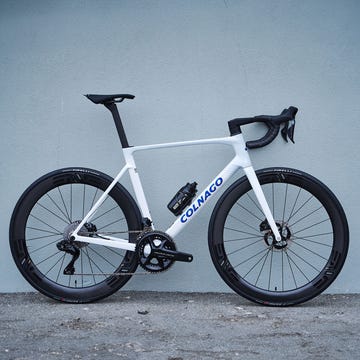Just 10 years ago, most high-quality bikes sold in the United States were made from aluminum or related alloys. As recently as 2003, our annual Buyer’s Guide featured only a handful of carbon-fiber models. And in the first years of this century, pros rode aluminum race bikes alongside carbon-fiber models at the sport’s most celebrated events.
Then the carbon-composite craze took hold and so commenced the great aluminum disappearing act. High-end road bikes were the first to go. Top-of-the-line hardtail mountain bikes were next, quickly followed by suspension and midpriced bikes. Aluminum’s 20-year run at the pinnacle of the sport ended with shocking abruptness.
By 2005, most manufacturers had relegated aluminum to value models and hybrids, but a few continued to build impressive frames out of it. More recently, improvements to the way the metal can be manipulated have led to better-performing bikes, encouraging large and small builders to re-embrace aluminum’s value and performance. Nowadays, the material increasingly occupies an important niche between entry-level models and expensive carbon machines, in both road and mountain bikes. And there are few signs that aluminum’s resurgence will slow.
Elements of Choice
The earliest widely available aluminum frames were made in the mid-1970s by brands like Vitus and Alan. They were built with straight-gauge tubing that was similar in diameter to the steel tubes commonly used at the time. These so-called “glued and screwed” frames (a reference to their construction, which relied on mechanical joints rather than welds) had a pleasant ride quality, but were overly flexy, making them scary on descents and ineffective in sprints.
Cannondale and Klein pioneered aluminum 2.0 in the 1980s and early ’90s—the light, stiff frames were TIG-welded from thin, large-diameter, straight-wall tubes. Oversize aluminum frames originally were designed for durability, says Chuck Teixeira, a 28-year veteran of Easton’s materials department who now directs advanced R&D for Specialized. But extending the life span of the bikes came with an unintended consequence: an immense stiffness that created a harsh ride. As a result, the metal earned a bad rap that has proven hard to shake, even though stiffness isn’t an inherent property of the material.
By the mid ’90s, just as builders were beginning to make oversize aluminum frames more compliant, the carbon wave hit and many shifted their focus to the new lightweight material. But not everyone abandoned aluminum. Some builders, like Cannondale, stayed the course. Others, like Craig Gaulzetti, who started producing frames in 2008, jumped in after realizing that aluminum offered a unique mix of characteristics that no other material could replicate. Until recently, the custom bike builder never felt the lure of steel—the darling of the handmade movement—or the increasingly in-demand carbon fiber.
“I made custom racing bikes out of aluminum because I wasn’t getting the ride quality I wanted from stock carbon race bikes,” Gaulzetti says. He was drawn to the metal for the same reasons bike makers originally were: It’s light, easy to work with, and can take on a variety of personalities in the hands of a skilled builder. These qualities are at the heart of aluminum’s renaissance, in both custom and mass-production bike making.
Related: Peeling Back the Layers of Carbon Fiber Frames
Also playing a role are recent innovations in manufacturing techniques that allow brands to build lower-cost aluminum bikes that have a ride quality similar to carbon models, says Teixeira. One of the key advances has been the widespread adoption of hydroforming, a process that uses pressurized hydraulic fluid to press aluminum into intricate shapes. The technique allows builders to create light, stiff, and strong frames that don’t have the buckboard ride of past models.
Although aluminum’s advances have been impressive, even the best tubes can’t match the stiffness or weight savings of high-grade carbon fiber. But the gap is closing and, importantly, aluminum comes at a lower price. According to Nova Cycles Supply, a major supplier of tubesets to custom frame builders, preassembled carbon-fiber rear triangles can sell for almost three times as much as complete Columbus aluminum versions. And Specialized’s Teixeira says global demand is inflating carbon’s price at a faster rate than aluminum’s.
The metal’s physical qualities are also winning over custom builders, who traditionally have favored steel or titanium pipes. Aluminum is about a third as dense as steel, and what it lacks in inherent stiffness can be made up by forming the tubes into stronger structures. Unlike titanium, which is so hard that it wears out tools used to cut and shape it, aluminum is relatively soft. This makes it easier to manipulate into tubes of varying thicknesses and shapes—yet another quality that is partly responsible for aluminum’s comeback.
Material Witnesses
Gaulzetti isn’t the only custom bike maker who believes in aluminum. Chris Herting of 3D Racing, and others like him, have continued to craft frames from it, even as carbon and steel have risen in popularity. And several major companies have either stayed the course or circled back to it. Cannondale, which rolled out its first aluminum model in 1983, was among the few major manufacturers that never abandoned the material, continuing to produce race-ready aluminum bikes even as its carbon SuperSix, Flash, and Scalpel frames rose to the top of the line. The company’s latest aluminum race bike, the CAAD10, debuted in 2011 and was “a major improvement” over previous iterations, says Chris Peck, Cannondale’s vice president of R&D. (The bike won a 2012 Bicycling Editors’ Choice award, topping several carbon competitors.) The refinement—and commitment—continues independent of the carbon models. “I won’t say when,” Peck says, “but in the future there will be more innovation.”
Other companies have revitalized their lines or reintroduced them altogether. After years of splitting its road-bike offerings between carbon (performance) and aluminum (recreational), Jamis’s new Icon line (reviewed on page 84) consists of aluminum race bikes, and the company claims the 1,150-gram frames are as light as those in its carbon-fiber Xenith Pro and Race series. Specialized’s Allez models have always been aluminum, but in 2013 the top-of-the-line bikes feature a new frame—the first one in seven years. The company has found a new way to hydroform tubes, called SmartWeld technology, that lets it strengthen joints and engineer more complex shapes to accommodate oversize head tubes for tapered steerers and oversize bottom brackets.
Specialized holds a patent on that process—and Giant and Cannondale also have developed exclusive methods for manipulating aluminum tubes. That means small builders who have traditionally purchased stock tubes have needed creative ways to incorporate these same features used by major companies. 3D’s Herting, who has been building aluminum bikes for more than 20 years and was once a member of Easton’s inner product-development circle, says that small builders’ access to tubesets that accommodate oversize head tubes and other current frame standards is slowly improving. Meanwhile, Gaulzetti uses a custom tubeset built to his design and produced by Italian company Dedacciai, then machines his own oversize head tubes and bottom brackets. But that comes at a cost. While Herting’s custom frames start around $1,350, a Gaulzetti Corsa will set you back $2,800.
Shaping the Future
Aluminum has impressive potential, but the material’s future is difficult to predict. Its fate depends on how committed big bike makers are, and what happens to the price for raw carbon and other materials. Assuming carbon prices remain flat or rise, aluminum likely will continue to be the material of choice on bikes that cost between $1,800 and $3,500, says Cannondale’s Peck.
Indeed, aluminum is finding a reliable performance-bike niche that may prove more sustainable than its boom-and-bust past. If you’re in the market for a road bike and want the best performance for the buck, look at aluminum. “For a rider not wedded to the idea of a carbon bike, it represents a great value,” says Peck, who adds that aluminum is popular among shop employees who race.
Related: BMC ALR01 Ups the Ante for Aluminum Road Bikes
In the end, aluminum’s most striking impact may come at the hands of craftsmen like Gaulzetti. While he is a custom frame builder, he’s no traditionalist. For his day job he manages Boston’s International Bicycle Center, where he sells bikes from Trek, Ibis, and Pinarello. And he freely admits that the best carbon bikes today are nothing short of amazing. His niche, however, is rooted in the spirit of the ingenious, creative tinkerer. Custom frame builders have long attracted customers by promising something unique and more personal than what a big bike manufacturer offers. But Gaulzetti wasn’t interested in simply being different; he wanted to build a bike that, from a performance standpoint, rode like none he’d experienced.
To do this, he needed a material he could design himself, not in Asia with a manufacturing partner. He needed a material that offered him the chance to customize his own parts, in his own workshop. And he needed a material that could satisfy the myriad, at times even contradictory, needs of a discerning cyclist. To move forward, all he had to do was look back.














